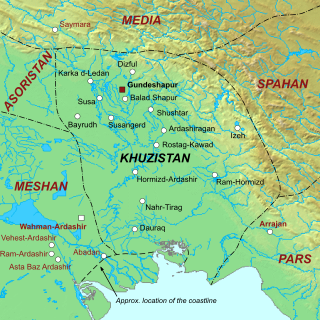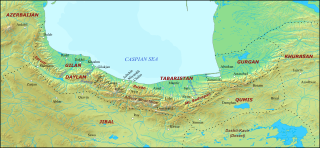Related Research Articles

Khosrow II, also known as Khosrow Parviz, is considered to be the last great Sasanian king (shah) of Iran, ruling from 590 to 628, with an interruption of one year.

Yazdegerd III was the last Sasanian King of Kings of Iran from 632 to 651. His father was Shahriyar and his grandfather was Khosrow II.

The Muslim conquest of Persia, also known as the Arab conquest of Iran, was carried out by the Rashidun Caliphate from 633 to 654 AD and led to the fall of the Sasanian Empire as well as the eventual decline of the Zoroastrian religion.

Samura ibn Jundab al-Fazārī was a companion of the Islamic prophet Muhammad who fought at the Battle of Uhud in 627 and later participated in the Muslim conquest of Iran in the 630s–640s. In 670–673 he served as the lieutenant governor of Basra under Ziyad ibn Abihi, the supreme governor of Iraq and the eastern Umayyad Caliphate. During his deputy rule over Basra, he is held by the Islamic traditional sources to have ordered wide-scale executions of Kharijites in his jurisdiction. He remained governor of Basra under the Umayyad caliph Mu'awiya I for six to eighteen months after Ziyad's death in August/September 673 until the Caliph replaced him.
Abd al-Rahman ibn Khalid ibn al-Walid was the governor of Homs under caliphs Uthman and Mu'awiya I. During Mu'awiya's governorship of Syria (639–661), Abd al-Rahman commanded a number of campaigns against the Byzantine Empire and defended the Upper Mesopotamian frontier from the Iraq-based forces of Caliph Ali. He fought reputably against the latter at the Battle of Siffin in 657 and continued his governorship of Homs and campaigns against the Byzantines after Mu'awiya became caliph in 661. His battlefield reputation and descent from his father, the prominent general Khalid ibn al-Walid, made him particularly popular among the Arabs of Syria. Mu'awiya ultimately perceived him as a potential rival of his own son Yazid, who he was grooming as his successor, which led the caliph to allegedly order Abd al-Rahman's poisoning in 666.

The Muslim conquest of Khuzestan took place from 637/8 to 642, and ended with the acquisition of the rich Khuzestan Province by the Rashidun Caliphate.

The Battle of Ullais was fought between the forces of the Rashidun Caliphate and the Sasanian Persian Empire in the middle of May 633 AD in Iraq, and is sometimes referred to as the Battle of Blood River since, as a result of the battle, there were enormous amounts of Persian Sasanian and Arab Christian casualties.
Hulwan was an ancient town on the Zagros Mountains in western Iran, located on the entrance of the Paytak Pass, nowadays identified with the town of Sarpol-e Zahab.
Al-Mada'in was an ancient metropolis situated on the Tigris River in modern-day Iraq. It was located between the ancient royal centers of Ctesiphon and Seleucia, and was founded by the Sassanid Empire. The city's name was used by Arabs as a synonym for the Sassanid capital of Ctesiphon, in a tradition that continued after the Arab conquest of Iran.

Tabaristan or Tabarestan, was the name applied to a mountainous region located on the Caspian coast of northern Iran. It corresponded to the present-day province of Mazandaran, which became the predominant name of the area from the 11th-century onwards.

Hormuzan was a Persian aristocrat who served as the governor of Khuzestan, and was one of the Sasanian military officers at the Battle of al-Qādisiyyah. He was later taken prisoner by the Muslims after the fall of Shushtar in 642. Two years later, he was accused of the assassination of the Rashidun caliph Umar, and was killed by 'Ubaid-Allah, the deceased caliph's son.

The Battle of al-Qadisiyyah was an armed conflict which took place in 636 CE between the Rashidun Caliphate and the Sasanian Empire. It occurred during the early Muslim conquests and marked a decisive victory for the Rashidun army during the Muslim conquest of Persia.
Piruz Khosrow, also known as Piruzan or Firuzan, was a powerful Persian aristocrat who was the leader of the Parsig (Persian) faction that controlled much of the affairs of the Sasanian Empire during the Sasanian civil war of 628-632. He was killed at the Battle of Nahāvand in 642.
Mihran-i Bahram-i Razi, better simply known as Mihran Razi, was an Iranian military officer from the Mihran family. He was killed in 637 at the battle of Jalula.
Aspad Gushnasp, known as Gousdanaspa in Byzantine sources, was an Iranian commander (hazarbed) of the Sasanian royal guard, who played a key role in the overthrow of the last great Sasanian king (shah) Khosrow II and the enthronement of the latter's son, Kavad II Sheroe.

The siege of Shushtar was fought from 641 to 642 between the Sasanian Empire and the invading Arab Muslims of the Rashidun Caliphate. Shushtar was an ancient strong stronghold in Khuzestan, and was attacked by the Arabs under their commander Abu Musa Ashaari. Although the city managed to resist the Arabs, the Sasanians later faced desertion, which resulted in the Arabs capturing the city and capturing its commander, Hormuzan.
Busbuhra was a local ruler of Aramean origin, who shifted alliance between the Rashidun Caliphate and the Sasanian Empire, to remain on his throne.

Amghishiya was a Sasanian city or fortress located near the former Lakhmid capital of al-Hira. It was known as a major defensive headquarter. In 633, during the Muslim conquest of Persia, a battle took place in one of its satellite military posts, Ullais, where the Muslim Arabs defeated a combined army of Sasanian-Christian Arab troops. Amghishiya was thereafter invaded and sacked by the Muslim military officer Khalid ibn al-Walid, while the survivors of the place fled to the countryside.
Ghalib ibn Abd Allah al-Laythi also known as Ghalib ibn Fadala al-Laythi, was an early companion and commander of the Islamic prophet Muhammad. During the prophet's lifetime, he led several expeditions against the polytheistic Bedouin tribes. He later participated in the conquest of Iraq in 634–636 and briefly as a commander in Khurasan in 668–671.
Al-Hakam ibn Amr al-Ghifari, was a companion of Muhammad and the Umayyad governor of Khurasan and commander of Arab expeditions into Transoxiana from 665 until his death in Merv.
References
- ↑ Minorsky 1958, p. 18.
- 1 2 Al-Tabari 1989, pp. 2421–2423.
- ↑ Morony 2005, p. 193.